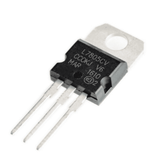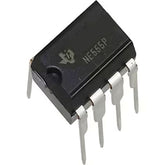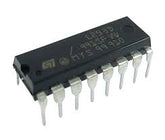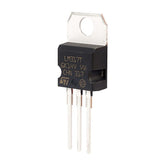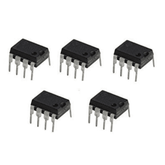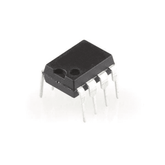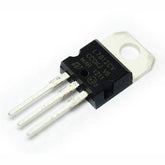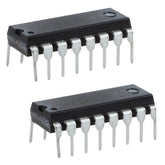All about integrated circuits(ICs): Types, Uses and more
Summary
Explore the fascinating world of integrated circuits (ICs) with our detailed blog. Discover what an IC is and delve into its rich history, from inception to modern advancements. Understand the immense importance and transformative impact ICs have had on technology and everyday life. Get acquainted with the basic types of ICs and their diverse applications. Whether you're a tech novice or an industry veteran, our blog offers valuable insights to enhance your understanding of ICs. Click now to learn all about integrated circuits and stay ahead in the tech game!
What is an Integrated Circuit (IC)?
Imagine holding the entire New York city--with its subways, skyscrapers and bustling streets in hands. This is how is an integrated circuit (IC) is, but on a smaller scale.
Also called a microchip, also known as a chip IC is an incredibly small electronic device that can fit millions or billions of microscopic parts onto the same semiconductor substrate.

But don't let their tiny dimensions fool you. These tiny marvels of engineering are invisible heroes that power nearly all modern electronic devices you could think of including the mobile phone that you carry in your pocket or the sleek computer that sits on your desk.
Without ICs the world would come to an abrupt halt. Intrigued? Let's dive deeper!
History of ICs
The beginnings of integrated circuits can be traced to an era of revolution in 1947, when three brilliant minds -John Bardeen Walter Brattain, and William Shockley -- at Bell Labs unveiled their groundbreaking invention, the transistor.
The tiny device, which was capable of controlling electron flow and allowing for the creation of solid-state electronics and the diminution of electronics components.
Now, fast forward to the year 1958 and we're blessed with two pioneers, Jack Kilby at Texas Instruments and Robert Noyce at Fairchild Semiconductor independently coming up with the concept of the integration of several electronic components on one semiconductor substrate.
Boom! A new integrated circuit came into existence. the rest like to the legend, is the history of technology.
Importance and Impact of ICs
Imagine reading this piece on a laptop that is the size of a room, or making a phone call on a device like a refrigerator that is as large. Because of integrated circuits, people are able to stay away from these inconveniences.
The IC revolutionized the electronic sector, which has enabled the production of more efficient and small devices that have changed the way we live our the modern world.
The computers which power our homes and offices to the phones which keep us connected, including the robots which assemble our vehicles to the life-saving medical devices that track our health, the integrated circuits make up the heroes who allow it all to be possible.
However, their impact doesn't end there. They also play significant roles in developing areas such as science and space exploration as well as entertainment.
Therefore, the next moment you stream your favorite show or play a thrilling video game, take the time to be amazed by the small marvels which make it happen.
Basic IC Types
Analog vs Digital Circuits
Before we go into the details of integrated circuits, we should tackle a fundamental issue What is the main difference between digital and analog circuits?
It's similar to the long-running debate over smooth jazz and rock music. Both have distinct styles and uses.
Analog (Linear) Circuits
Analog circuits, also referred to as linear circuits are the smooth jazz of electronics.
They are designed for continuous signal processing which can take on any form within a particular range, similar to the seamless changes between notes in an instrumental jazz piece.
These circuits are typically utilized in applications that communicate to the world around us, for example the amplifying of audio signals, filtering noise or controlling devices that are based on sensors' inputs.
Consider them as translators, taking the complex real-world data, and translating it into the digital world.
Digital Circuits
On the contrary digital circuits are the electronic rock stars of the world, working on discrete signals that only have two distinct values, usually depicted as 0 and 1 as well as "off" and "on."
They're the core of modern data processing and computing which manipulates and stores information in binary format. Imagine trying to capture the intricate jazz harmonies together just two notes.
That's the challenge that digital circuits are faced with yet they are able to create complex symphonies based on computation and processing of data.
Binary Circuits and Boolean Logic
When it comes to symphonies in general digital circuits typically use binary logic, which is based on Boolean algebra to carry out their functions. It's similar to conducting a conductor who orchestrates the flow of 0s and 1, through logic gates, such as AND, OR, and not, creating intricate pattern of computing and making decisions.
Similar to a proficient musician, electronic circuit makers need to masterfully mix these basic components to design the complex circuits that run our modern world.
Microprocessor Circuits
When integrated circuits represent the center of the city and microprocessors are the tallest of the skyscrapers that make up its core with millions of digital microcircuits working in perfect harmony.

Let's look closer at these incredible feats of modern technology.
Central Processing Unit (CPU)
In the heart of every microprocessor is the central processing unit (CPU) that is the brain that executes logic and arithmetic operations executes instructions, and manages the flow of information in the computer system.
It's akin to the busy office at high up on the tower where the most important decisions are taken and the instructions are given.
Registers
However, even the most brilliant minds require somewhere to save their ideas and plans, isn't it? Registers are the specialized memory areas within microprocessors which are used to store information, addresses, and instructions.
Consider them like the whiteboards and filing cabinets that are all over the office, which are able to store important information and ensuring everything is in order.
Clock and Speed
Imagine running an office with no notion of timing or sync. It would be chaos! This is the reason microprocessors are equipped with the clock, which is a synchronizing signal used to control the operation of instructions and processes as a conductor would, making sure that the musicians are at a perfect tempo.
A processor's speed processor is measured by its clock speed that is which is measured in hertz (Hz) and higher frequencies providing faster computation speeds.
It's similar to having a metronome, which sets the tone for the entire office and ensures that everything is running seamlessly and smoothly.
Memory Circuits
What's the point of having an office if there's no place to keep all important documents and documents?

This is where memory circuits step into the picture, serving as the massive archive and information centers in the world of integrated circuits.
Dense Arrays
Memory circuits consist of a dense collection of parallel circuits that utilize their voltage states to store data as do rows and row of file cabinets stuffed with well-organized documents.
Size Reduction Efforts
Just like any other good-run company manufacturers are always seeking to improve their storage solutions.
They work at a feverish pace to reduce the size of memory circuits and expanding their capacity.
This is like figuring out innovative methods to squeeze additional filing cabinets within smaller areas and all for the sake of efficiency and growth.
Digital Signal Processors (DSPs)
Do you remember the last time that efforts to talk in a noisy establishment or struggled to listen to people on a noisy phone line?

This is where digital signal processing (DSPs) are in the picture and act as noise-canceling headphones in the integrated circuits.
Analog to Digital Conversion
DSPs are specially-designed integrated circuits that handle analog signal that has been transformed to digital form.
It's similar to taking a messy real-world sound wave and transforming it into binary numbers which can be easily altered and interpreted.
Digital Processing Capabilities
When the signal is converted to digital format, DSPs can perform complex mathematical operations and manipulates together specific algorithms, such as an experienced audio engineer who is meticulously altering and fine-tuning audio until it is perfect.
Applications (Noise Filtering, Visual Effects)
From removing background noise from broadcasts, to creating stunning visual effects and graphics overlays to the live broadcast, DSPs are the unsung heroes that make our entertainment experience really immersive and exciting.
Application-Specific ICs (ASICs)
Have you ever been amazed by the incredible versatility of the Swiss Army knife, with the variety of tools that are specifically designed for specific jobs? It's true, Application-Specific Integrated Circuits (ASICs) are the integrated circuit equivalent to the handy multi-tools.

In contrast to general-purpose microprocessors that are similar to the traditional knife blade that is used to perform a range of tasks, but not specifically designed for any specific task, ASICs are designed for specific functions, whether either analog or digital.
They're the bottle openers screwdrivers and knives from the IC world, designed specifically for specific purposes and tasks.
Radio-Frequency ICs (RFICs)
Monolithic Microwave ICs (MMICs)
A specific kind of RFIC is referred to as the monolithic microwave integrated circuit (MMIC) is similar to it's high-speed internet of IC world operating at frequencies of microwaves and enabling technologies such as radar systems satellite communications, and cell networks.

Imagine streaming your favourite movie using an old dial-up connection in the 90s. That's exactly the kind of sluggish speed we'd have to endure without the lightning-fast speeds provided by MMICs.
These special circuits are the unnoticed heroes who ensure that our wireless devices are humming through at lightning speeds that allow us to be connected regardless of where we travel.
Conclusion
When we're at the end of our journey into the intriguing world of integrated circuits, we should be sure to reflect on the main areas we've delved into.
From the astonishing tiny electronic components that are crammed onto one semiconductor substrate, to the intricate movement of electrons and holes which power these amazing devices We've witnessed how electronic circuits changed our lives in our work, play, and life. We've examined the different kinds of circuits, starting with the mellow jazz of analog circuits to the digital symphonies in binary each with its distinct strengths and uses.
We've seen the amazing architecture of the design of microprocessors, including its central processing unit, their specialized registers, and precisely-timed clock signals that control the processing of data and computation.
We've looked into the world of memory circuits as well as digital signal processors and applications-specific integrated circuits all of which play a crucial part in our increasingly connected and technologically advanced society. In the future we can be sure of one thing that integrated circuits continue to shape the world around us in ways that we cannot even imagine.
From creating groundbreaking breakthroughs in biotechnology and artificial intelligence to enabling the creation of the smart city and devices that are connected, these small engineering marvels will continue to be on the cutting edge of technological advancement.
And as they become more integral to our lives the impact they have on the economy, society and how people interact get more significant. When you ponder the technology that is all around us, stop to acknowledge the unsung heroes that made this all possible: those integrated circuits the tiny, tiny cities of silicon and steel which power our modern lives.



